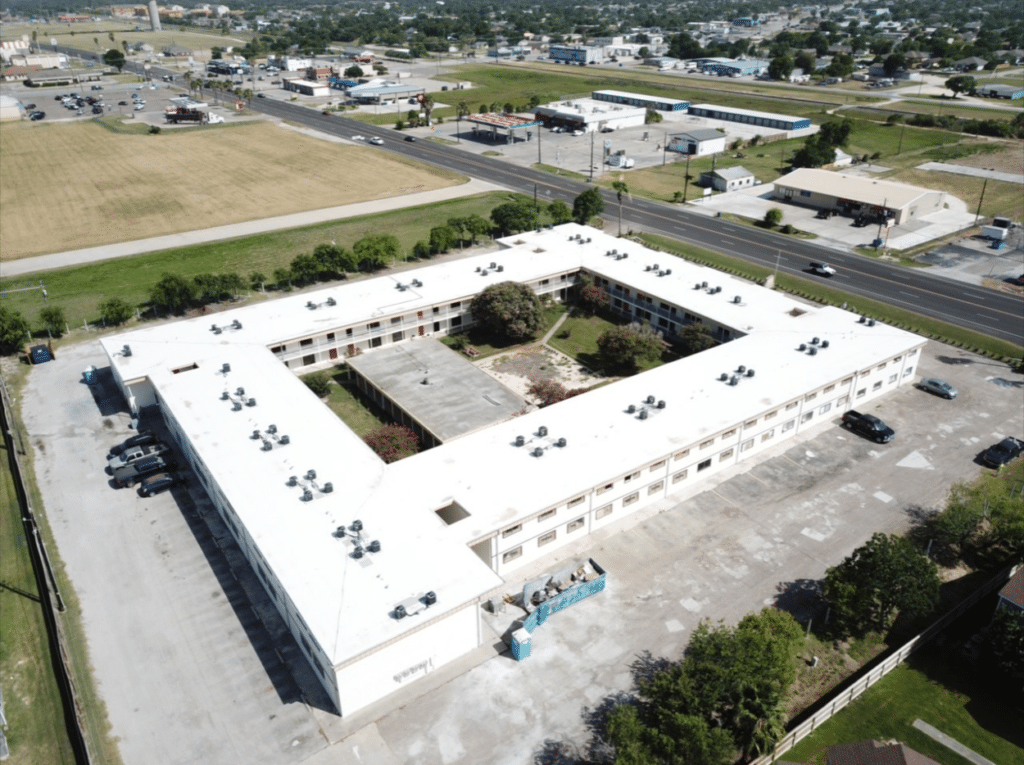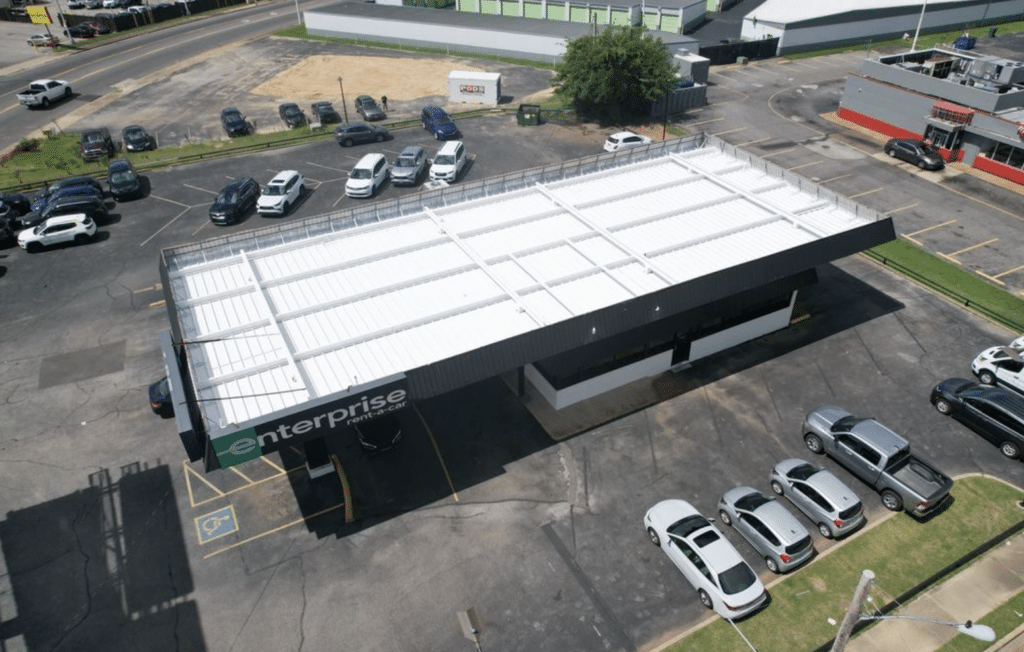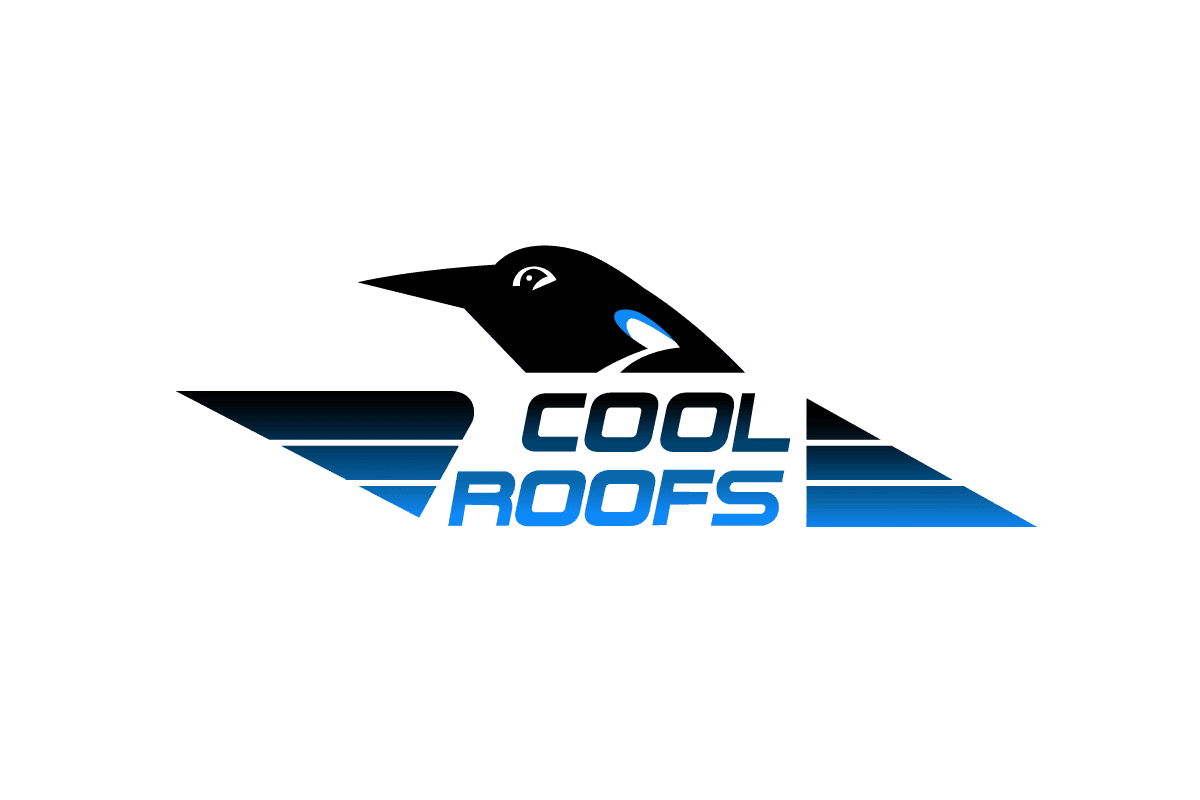Are you overwhelmed by the variety of commercial roofing options available for your business? Worry not! This comprehensive guide will walk you through the different types of commercial roofs and materials, helping you make an informed decision on the best option for your project. Get ready to uncover the secrets of commercial roofing systems and their materials, as well as the importance of insulation, vapor retarders, and choosing the right contractor for your needs.
Navigating the World of Commercial Roofing SystemsKey Takeaways
- Understanding the various types of commercial roofing systems is essential for informed decisions.
- Common types of commercial roofs include flat, low-sloped, and pitched roofs with specialized materials such as EPDM, TPO, PVC & metal roofing.
- When selecting a contractor verify their licensing & insurance. Evaluate portfolio & obtain references from past clients.
Understanding Commercial Roofing Systems

The world of commercial roofing systems may seem vast and confusing at first. However, understanding the various types of commercial roofing systems can guide you to make informed decisions for your project, taking into consideration factors such as slope, building usage, and materials. From low slope roofs in commercial buildings to steep slope roofs in residential structures, each type of commercial roofing system presents unique benefits and challenges.
Now, let us navigate through the diverse world of commercial roofing systems and decipher the intricacies of their types.
Low Slope vs. Steep Slope Roofs
Low slope roofs, also known as flat roofs, are commonly found in commercial buildings, while steep slope roofs are more typical in residential structures. Low slope roofs have a minimal incline, providing better water runoff and easier installation compared to their steep slope counterparts. On the other hand, steep slope roofs offer excellent water and snow runoff, but their steep incline can make maintenance more challenging and expensive.
The choice between low slope and steep slope roofs depends on factors such as the building’s purpose, geographical location, and aesthetic preferences. Knowledge of the differences between these two types of roofs will guide you in determining the most suitable option for your commercial property.
Commercial vs. Residential Roofing
Commercial and residential roofing systems have some key differences:
- Commercial roofs tend to be larger in terms of square footage and usually feature a low or flat slope.
- Residential roofs are typically smaller and possess a steeper slope.
- Slope commercial roofing experts possess specialized training and experience in dealing with larger roofs and intricate commercial structures, including metal roofing systems.
When it comes to materials, residential roofs commonly utilize asphalt shingles. On the other hand, commercial roofs may employ a variety of materials, including:
- Metal
- EPDM
- TPO
- PVC
This variation in materials and design accommodates the unique requirements of commercial buildings, such as energy efficiency, durability, and resistance to weather conditions.
Common Types of Commercial Roofs
Whether you are constructing a new commercial property or renovating an existing one, you should familiarize yourself with the common types of commercial roofs. The type of roof you choose will depend on factors such as the building’s structure and your specific needs. Types of commercial roofs typically include flat, low-sloped, and pitched. Each type is constructed differently to meet the needs of a variety of building structures. Each type has its own advantages and disadvantages, making it vital to assess your building’s specific needs and requirements before making a decision.
In the following sections, we’ll examine these common commercial roof types in detail to assist you in making an informed choice.
Flat Roofs
Flat roofs have been a staple of commercial flat roofing since the 1920s. They are cost-effective, energy-efficient, and simple to maintain, making them an attractive option for many commercial properties. However, flat roofs may suffer from inadequate drainage and necessitate experienced contractors for installation and repairs.
To circumvent potential issues with flat roofs, it is advisable to hire a seasoned commercial roofing contractor who is well-versed in the placement of drains and the suitable elevation to prevent puddling. They can also recommend the best materials for your flat roof, such as ethylene propylene diene monomer (EPDM) rubber, modified bitumen, or spray polyurethane foam.
Low-Sloped Roofs
Low-sloped roofs, also known as ‘flat roofs’, have a minimal slope for water drainage and are cost-effective, energy-efficient, and easy to maintain. Materials commonly used for low-slope roofs include shingles, membranes, and metal. A well-installed and maintained low-sloped roof can have a lifespan of up to 40 years, offering numerous benefits for commercial property owners.
However, low-sloped roofs may be susceptible to heavy snow loads and must comply with building regulations. Despite these challenges, low-sloped roofs remain a popular choice for low slope commercial buildings such as factories, warehouses, and apartment buildings due to their efficiency and ease of installation.
Pitched Roofs
Pitched roofs provide excellent water and snow runoff, making them a suitable option for commercial properties in areas with heavy precipitation. However, their steep incline can make maintenance more challenging and expensive. The materials used for pitched roofs in commercial settings can vary, with some popular choices being:
- Metal roofs
- Asphalt shingles
- Clay or concrete tiles
- Slate
- Wood shakes or shingles
Each material has its own advantages and considerations, so it’s important to choose the one that best suits your specific needs and budget.
While pitched roofs may not be as common in commercial buildings as flat or low-sloped roofs, they offer unique advantages such as improved water drainage and a visually appealing design. In addition, a properly installed and maintained pitched roofing system can provide a lifespan of up to 40 years.
Popular Commercial Roofing Materials
Alongside understanding the different types of commercial roofs, getting acquainted with the various commercial roofing materials is equally crucial. Some of the most popular commercial roofing materials in use today are:
Each material has its own set of pros and cons in terms of durability, cost, and energy efficiency.
In the subsequent sections, we will probe into each of these popular commercial roofing materials and their distinctive features.
EPDM Roofing
EPDM roofing is a roll-based, durable synthetic rubber roofing membrane that is widely used in commercial and residential roofing applications. Its cost-effective and resilient nature makes it an attractive option for many commercial property owners. However, EPDM roofing may be vulnerable to punctures and requires regular upkeep.
The seams in EPDM roofing are typically sealed with adhesives or seam tape, which may be susceptible to degradation due to UV sunlight. Despite these drawbacks, EPDM roofing remains a popular choice for commercial properties due to its durability and affordability.
TPO Roofing
TPO roofing is a thermoplastic polyolefin roofing solution that is gaining traction among commercial building owners. TPO roofing offers the following benefits:
- Economical
- Pliable
- Excellent energy efficiency
- Resistance to UV rays
However, due to its relatively recent use in roofing applications, there is some uncertainty regarding its longevity in comparison to PVC or EPDM roofs.
Despite its shorter track record, TPO roofing has gained popularity due to its cost-effectiveness, flexibility, and environmentally-friendly nature. As more commercial building owners opt for TPO roofing, its performance and longevity will become more evident over time.
PVC Roofing
PVC roofing is a widely-used and reliable membrane material utilized in roofing today. Comprised of two layers of PVC roof material with polyester reinforcement between the layers, PVC roofing provides exceptional longevity and energy efficiency. However, it may shrink over time, leading to potential leaks, and repairs may be complicated.
While PVC roofing may be more expensive than other materials such as TPO and EPDM, its benefits make it a popular choice for commercial property owners. These benefits include:
- Durability
- Longevity
- Energy efficiency
- Warranty
- Fire resistance
Metal Roofing
Metal roofing, composed of materials such as aluminum, steel, copper, or zinc, is frequently employed in commercial and industrial buildings for its:
- longevity
- minimal maintenance requirements
- durability
- fire-resistance A metal roof offers these benefits, making it a popular choice for many projects.
Metal roofs provide decades of service with proper maintenance. However, they may be prone to corrosion and have a greater initial expense than other roofing materials.
Despite the higher upfront cost, metal roofing remains a popular choice for commercial and industrial buildings due to its:
- Durability
- Low-maintenance requirements
- Attractive appearance
- Fire resistance
- Ability to withstand harsh weather conditions
These qualities make it an ideal material for buildings in various climates.
The Importance of Insulation and Vapor Retarders
Insulation and vapor retarders form integral parts of a commercial roof system, enhancing energy efficiency and safeguarding the building from moisture damage. Some insulation materials used in commercial roof systems include:
- Polyisocyanurate
- IKO Fire Rated Roofing Systems
- IKO Reflective and Eco Roofing Systems
- IKO MVP Modified Vapour Protector
Proper insulation and vapor retarders can provide improved energy efficiency, protection from moisture damage, and reduced heating and cooling costs.
Incorporating insulation into a commercial roof system would be most effective when the roof is undergoing replacement. By ensuring that your commercial roofing project includes proper insulation and vapor retarders, you can improve the energy efficiency of your building and protect it from potential moisture-related issues.
Choosing the Right Commercial Roofing Contractor
Choosing an appropriate commercial roofing contractor is pivotal for a successful roofing project. Here are some significant steps to ensure a successful project:
- Verify their licensing and insurance.
- Evaluate their portfolio to see examples of their previous work.
- Obtain references from past clients to get feedback on their performance.
In this section, we will explore in-depth the considerations when selecting a commercial roofing contractor to help you make an apt choice for your project.
Licensing and Insurance
Licensing and insurance are essential for commercial roofing contractors, as they provide protection for both the contractor and the customer. Licensing confirms the contractor’s qualifications to complete the project, while insurance safeguards both parties from any potential damages or liabilities that could occur during the project. Commercial roofing contractors should possess general liability insurance, workers’ compensation insurance, and property damage insurance.
By verifying a contractor’s licensing and insurance, you ensure they have the required qualifications and coverage to safeguard both parties from any potential damages or liabilities that might occur during the project.
Portfolio and References

Possessing a portfolio and references is vital when choosing a commercial roofing contractor, as it provides a record of the contractor’s experience and quality of work. A portfolio may include images of completed projects, customer feedback, and other pertinent information, while references may consist of former clients, vendors, and other professionals who have collaborated with the contractor.
When evaluating a contractor’s portfolio and references, look for examples of work similar to your project, customer testimonials, and a track record of success. This will help you determine whether the contractor has the expertise and experience necessary to complete your commercial roofing project successfully.
Summary
In conclusion, understanding the different types of commercial roofs and materials is crucial for making informed decisions on the best option for your project. From flat roofs, low-sloped roofs, and pitched roofs to popular materials such as EPDM, TPO, PVC, and metal roofing, each type of commercial roofing system has its own set of advantages and disadvantages. Additionally, the importance of insulation, vapor retarders, and choosing the right commercial roofing contractor cannot be overstated. By considering all these factors, you can confidently select the perfect commercial roofing solution for your building, ensuring long-lasting protection, energy efficiency, and aesthetic appeal.
Contact Us For Your First Complimentary Roof Assessment
Frequently Asked Questions
What is the best roofing for commercial?
Metal roofing is the best choice for commercial buildings due to its long-lasting durability and low maintenance. It may require a higher upfront investment, but it will pay off over time with its decades-long lifespan. Built-Up Roofing Systems (BUR) and Single-Ply roofing systems are also popular choices for commercial buildings.
What is the most common type of commercial roof?
Single-ply membranes are the most popular type of commercial roofing material due to their durability, resistance to tears and leaks, and easy installation. Asphalt shingles also offer versatility and affordability, while metal roofing is a popular choice due to its many materials and design options. EPDM roofing systems are also widely used for new or re-roofing applications.
What is the strongest roofing system?
Slate and clay are the strongest roofing materials, boasting life expectancies of more than 150 years and 100 years respectively.
What factors should I consider when selecting a commercial roofing material?
When selecting a commercial roofing material, consider factors such as durability, cost, energy efficiency, and the specific needs of your building to ensure you make the best choice for your structure.
How long can I expect a well-installed and maintained commercial roof to last?
A well-installed and maintained commercial roof can generally provide a lifespan of up to 40 years.

